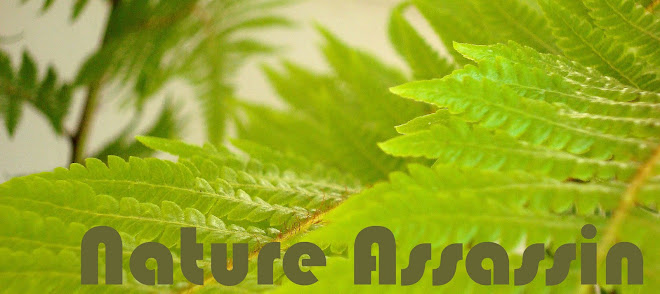1) Abutilon striatum 'Thompsonii' (aka A. pictum 'Thompsonii'). This is an orange-flowering variety of Abutilon, the Parlor Maple, with beautiful foliage as an added bonus. The variegation in the leaves is apparently caused by a virus, which is purposefully maintained through propagation. Fast growth, the ability to survive low humidity levels, and tolerance of a variety of light/temperature situations makes Abutilon a popular plant for indoor culture. I'll guess I'll find out soon enough if it deserves its popularity. Being a beautiful, rampant, ass-kicking grower of a plant and also victim of strange science, I have decided to dub my Abutilon "River Tam."

2) Calathea insignis (aka C. lancifolia), the Rattlesnake plant. Calatheas are tricky due to their incredible humidity requirements. It may be wishful to believe that I can make this plant survive a heated indoor winter, but try I must. I fell in love with this type of Calathea for its patterned leaves and deep burgundy leaf-undersides at the Garfield Conservatory (see this post). I was therefore delighted and surprised to find it at for sale at Rolling Ridge Nursery in Webster Groves, Missouri. Its only natural that this plant would be rare on store shelves, because it isn't well suited to anything but greenhouse life. It needs high heat, but detests hot draughts. It needs fresh air, but detests cold draughts. It needs high light, but detests direct sun. It needs lots of water and humidity, but detests overly wet roots. So, quite reasonably, I am enjoying owning this plant even though visions of plant murder dance in my head. As Dexter would say, "Do I see plastic sheets in your future?"


3) Senecio macroglossus 'Variegatus,' the Wax Ivy (or Cape Ivy) plant. Looks just like some kind of Hedera, doesn't it? But what ho! A squish-squish of the leaves between your fingers reveals that they are thick and succulent. This feature makes Senecio an excellent winter alternative to traditional ivies, or as I like to call them, "Old Country Spidermite Buffet." Senecio can tolerate shade or direct sun, medium or high humidity, and normal to cool room temperatures in winter. This plant, as well as the following plant and the Abutilon, were purchased from the incredibly sexy Bowood Farms in St. Louis.*

4) x Fatshedera lizei 'Aureamaculata." This plant has several goofy common names, my favorites being "Botanical Wonder" and "Fat-headed Lizzy." As the "x" in the name implies, this plant is a cultivated cross that combines the best features of its parents, Hedera (common Ivy) and Fatsia (Castor-oil plant). By all accounts, Fatshedera is a simple foliage plant, valued for its tolerance of poor growing conditions. Simple though it may be, the foliage of 'Aureamaculata' is anything but dull; in fact the variegation is transparent enough that it seems to glow from within. I find it very visually arresting.

5) And speaking of arresting, call the Boring Plant Police! Lithops optica 'Rubra' is running amok! That is sarcasm - this plant does nothing whatsoever. Lithops, or Living Stones plant, wants nothing in life but to be left alone... they can spend 20 years just hanging out before they will even fill a six inch pot, or so I've been told. My interest in this plant was piqued for the very first time when I saw this variety, 'Rubra,' at the much-touted Ted's Greenhouse in Tinley Park, Illinois. The beautiful wine-red color was unlike anything I'd ever seen in a succulent. They were being propagated and were not actually for sale, but being the freak that I am, I demanded that somebody sell me some. A gracious employee finally conceded two specimens for a hefty price, and I carried them home like precious jewels.

*I'm pretty sure, at this point, that Missouri has the best collection of commercial greenhouses in the Midwest. Especially when one considers my favorite, Ahner's Garden and Gifts.

I love that Calathea! Gotta get me one of those...even for a temporary period. Yup, Calatheas can be ulcer-inducing. It's almost impossible to keep them alive for very long, but try we must...
ReplyDeleteYour closeups are great.
ReplyDeleteI blogged recently about my Lithops rubra being in flower - ok it stays small, but it's so exciting when it blooms, perhaps because the plant seems so indifferent to my attentions, the rest of the time. Then i realised i'd had a brainstorm and didn't mean the rubra but another one. (I don't mean 'brainwave' but 'brain-d'oh moment'.)
But my Rubra HAS now flowered, and i had to time-lapse it while away for the New Year. Quite soon i hope to get those pix onto my blog too.
There is something rewarding about these relatively unresponsive plants. And they're clever little survivors. :0)
Yep Water Roots, can't help but love those little bastards. I hope your C. lubbersii is still kicking!
ReplyDeleteThanks, travelhopefully. I'll look for your pictures... cactus/succulent flowers are always so cool.
Thank you for the info. It sounds pretty user friendly. I guess I’ll pick one up for fun. thank u
ReplyDeleteCoolroom